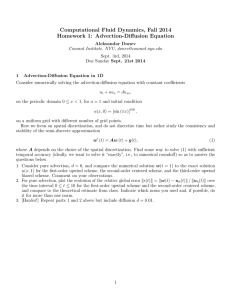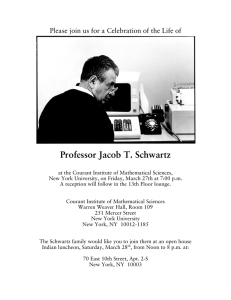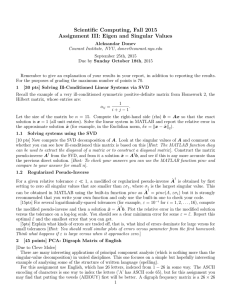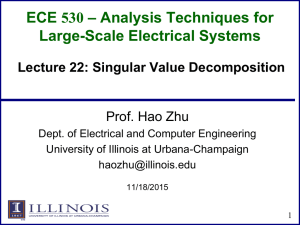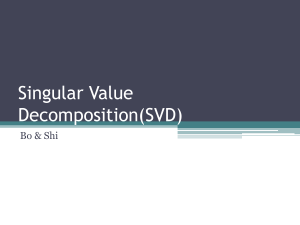Numerical Methods I Singular Value Decomposition Aleksandar Donev Courant Institute, NYU
advertisement
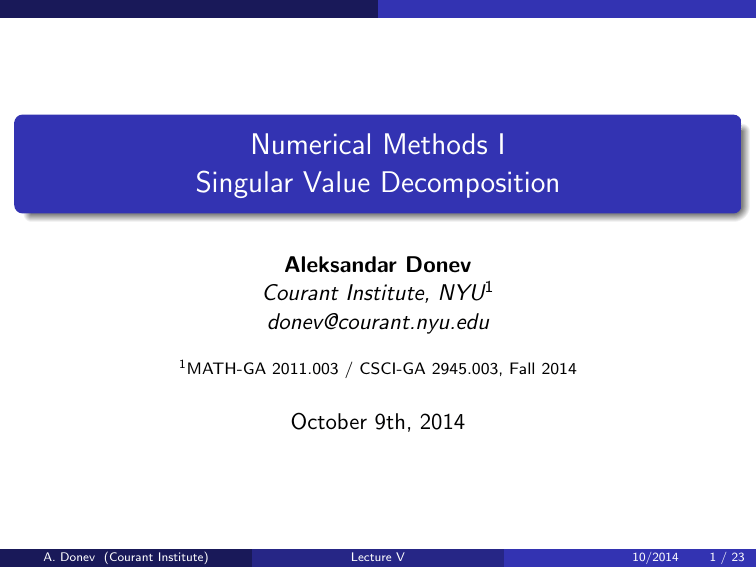
Numerical Methods I
Singular Value Decomposition
Aleksandar Donev
Courant Institute, NYU1
donev@courant.nyu.edu
1 MATH-GA
2011.003 / CSCI-GA 2945.003, Fall 2014
October 9th, 2014
A. Donev (Courant Institute)
Lecture V
10/2014
1 / 23
Outline
1
Review of Linear Algebra: SVD
2
Computing the SVD
3
Principal Component Analysis (PCA)
4
Conclusions
A. Donev (Courant Institute)
Lecture V
10/2014
2 / 23
Review of Linear Algebra: SVD
Formal definition of the SVD
Every matrix has a singular value decomposition
A =UΣV? =
p
X
σi ui v?i
i=1
[m × n] = [m × m] [m × n] [n × n] ,
where U and V are unitary matrices whose columns are the left, ui , and
the right, vi , singular vectors, and
Σ = Diag {σ1 , σ2 , . . . , σp }
is a diagonal matrix with real positive diagonal entries called singular
values of the matrix
σ1 ≥ σ2 ≥ · · · ≥ σp ≥ 0,
and p = min (m, n) is the maximum possible rank of the matrix.
A. Donev (Courant Institute)
Lecture V
10/2014
3 / 23
Review of Linear Algebra: SVD
Comparison to eigenvalue decomposition
Recall the eigenvector decomposition for diagonalizable matrices
AX = XΛ.
The singular value decomposition can be written similarly to the
eigenvector one
AV = UΣ
A? U = VΣ
and they both diagonalize A, but there are some important
differences:
1
2
3
The SVD exists for any matrix, not just diagonalizable ones.
The SVD uses different vectors on the left and the right (different
basis for the domain and image of the linear mapping represented by
A).
The SVD always uses orthonormal basis (unitary matrices), not just
for unitarily diagonalizable matrices.
A. Donev (Courant Institute)
Lecture V
10/2014
4 / 23
Review of Linear Algebra: SVD
Relation to Hermitian Matrices
For Hermitian (symmetric) matrices,
X = ±U = ±V
and
Σ = |Λ| ,
so there is no fundamental difference between the SVD and
eigenvalue decompositions.
The squared singular values are eigenvalues of the normal matrix:
p
p
σi (A) = λi (AA? ) = λi (A? A)
since
A? A = (VΣU? ) (UΣV? ) = VΣ2 V?
is a similarity transformation.
Similarly, the singular vectors are the corresponding eigenvectors up to
a sign.
A. Donev (Courant Institute)
Lecture V
10/2014
5 / 23
Review of Linear Algebra: SVD
Rank-Revealing Properties
Assume the rank of the matrix is r , that is, the dimension of the
range of A is r and the dimension of the null-space of A is n − r
(recall the fundamental theorem of linear algebra).
The SVD is a rank-revealing matrix factorization because only r of
the singular values are nonzero,
σr +1 = · · · = σp = 0.
The left singular vectors {u1 , . . . , ur } form an orthonormal basis for
the range (column space, or image) of A.
The right singular vectors {vr +1 , . . . , vn } form an orthonormal basis
for the null-space (kernel) of A.
A. Donev (Courant Institute)
Lecture V
10/2014
6 / 23
Review of Linear Algebra: SVD
The matrix pseudo-inverse
For square non-singular systems, x = A−1 b.
Can we generalize the matrix inverse to non-square or rank-deficient
matrices?
Yes: matrix pseudo-inverse (Moore-Penrose inverse):
A† = VΣ† U? ,
where
Σ† = Diag σ1−1 , σ2−1 , . . . , σr−1 , 0, . . . , 0 .
In numerical computations very small singular values should be
considered to be zero (see homework).
Theorem: The least-squares solution to over- or under-determined
linear systems Ax = b is
x = A† b.
A. Donev (Courant Institute)
Lecture V
10/2014
7 / 23
Review of Linear Algebra: SVD
Proof of Least-Squares (1)
A. Donev (Courant Institute)
Lecture V
10/2014
8 / 23
Review of Linear Algebra: SVD
Proof of Least-Squares (2)
A. Donev (Courant Institute)
Lecture V
10/2014
9 / 23
Review of Linear Algebra: SVD
Proof of Least-Squares (3)
A. Donev (Courant Institute)
Lecture V
10/2014
10 / 23
Computing the SVD
Sensitivity (conditioning) of the SVD
Since unitary transformations preserve the 2-norm,
kδΣk2 ≈ kδAk2 .
The SVD computation is always perfectly well-conditioned!
However, this refers to absolute errors: The relative error of small
singular values will be large.
The power of the SVD lies in the fact that it always exists and can
be computed stably...but it is expensive to compute.
A. Donev (Courant Institute)
Lecture V
10/2014
11 / 23
Computing the SVD
Computing the SVD
The SVD can be computed by performing an eigenvalue computation
for the normal matrix A? A (a positive-semidefinite matrix).
This squares the condition number for small singular values and is not
numerically-stable.
Instead, one can compute the eigenvalue decomposition of the
symmetric indefinite 2m × 2m block matrix
0 A?
H=
.
A 0
The cost of the calculation is ∼ O(mn2 ), of the same order as
eigenvalue calculation, but in practice SVD is more expensive, at
least for well-conditioned cases.
A. Donev (Courant Institute)
Lecture V
10/2014
12 / 23
Computing the SVD
Reduced SVD
The full (standard) SVD
A =UΣV? =
p
X
σi ui v?i
i=1
[m × n] = [m × m] [m × n] [n × n] ,
is in practice often computed in reduced (economy) SVD form, where Σ
is [p × p]:
[m × n] = [m × n] [n × n] [n × n]
[m × n] = [m × m] [m × m] [m × n]
for
for
m>n
n>m
This contains all the information as the full SVD but can be cheaper to
compute if m n or m n.
A. Donev (Courant Institute)
Lecture V
10/2014
13 / 23
Computing the SVD
In MATLAB
[U, Σ, V ] = svd(A) for full SVD, computed using a QR-like method.
[U, Σ, V ] = svd(A,0 econ0 ) for economy SVD.
For rank-defficient or under-determined systems the backslash
operator (mldivide) gives a basic solution.
Basic means x has at most r non-zeros (not unique).
The least-squares solution can be computed using svd or pinv
(pseudo-inverse, see homework).
A rank-q approximation can be computed efficiently for sparse
matrices using
[U, S, V ] = svds(A, q).
A. Donev (Courant Institute)
Lecture V
10/2014
14 / 23
Principal Component Analysis (PCA)
Low-rank approximations
The SVD is a decomposition into rank-1 outer product matrices:
A = UΣV? =
r
X
σi ui v?i =
i=1
r
X
Ai
i=1
The rank-1 components Ai are called principal components, the
most important ones corresponding to the larger σi .
Ignoring all singular values/vectors except the first q, we get a
low-rank approximation:
A ≈ Âq = Uq Σq V?q =
q
X
σi ui v?i .
i=1
Theorem: This is the best approximation of rank-q in the Euclidian
and Frobenius norm:
A − Âq = σq+1
2
A. Donev (Courant Institute)
Lecture V
10/2014
15 / 23
Principal Component Analysis (PCA)
Applications of SVD/PCA
Statistical analysis (e.g., DNA microarray analysis, clustering).
Data compression (e.g., image compression, explained next).
Feature extraction, e.g., face or character recognition (see
Eigenfaces on Wikipedia).
Latent semantic indexing for context-sensitive searching (see
Wikipedia).
Noise reduction (e.g., weather prediction).
One example concerning language analysis given in homework.
A. Donev (Courant Institute)
Lecture V
10/2014
16 / 23
Principal Component Analysis (PCA)
Image Compression
>>
>>
>>
>>
>>
>>
A=r g b 2 g r a y ( i m r e a d ( ’ b a s k e t . j p g ’ ) ) ;
imshow (A ) ;
[ U , S , V]= s v d ( d o u b l e (A ) ) ;
r =25; % Rank−r a p p r o x i m a t i o n
Acomp=U ( : , 1 : r ) ∗ S ( 1 : r , 1 : r ) ∗ (V ( : , 1 : r ) ) ’ ;
imshow ( u i n t 8 ( Acomp ) ) ;
A. Donev (Courant Institute)
Lecture V
10/2014
17 / 23
Principal Component Analysis (PCA)
Compressing an image of a basket
We used only 25 out of the ∼ 400 singular values to construct a rank 25
approximation:
A. Donev (Courant Institute)
Lecture V
10/2014
18 / 23
Principal Component Analysis (PCA)
Principal Component Analysis
Principal Component Analysis (PCA) is a term used for low-rank
approximations in statistical analysis of data.
Consider having m empirical data points or observations (e.g., daily
reports) of n variables (e.g., stock prices), and put them in a data
matrix A = [m × n].
Assume that each of the variables has zero mean, that is, the
empirical mean has been subtracted out.
It is also useful to choose the units of each variable (normalization) so
that the variance is unity.
We would like to find an orthogonal transformation of the original
variables that accounts for as much of the variability of the data as
possible.
Specifically, the first principal component is the direction along which
the variance of the data is largest.
A. Donev (Courant Institute)
Lecture V
10/2014
19 / 23
Principal Component Analysis (PCA)
PCA and Variance
A. Donev (Courant Institute)
Lecture V
10/2014
20 / 23
Principal Component Analysis (PCA)
PCA and SVD
The covariance matrix of the data tells how correlated different pairs
of variables are:
C = AT A = [n × n]
The largest eigenvalue of C is the direction (line) that minimizes the
sum of squares of the distances from the points to the line, or
equivalently, maximizes the variance of the data projected onto that
line.
The SVD of the data matrix is A = UΣV? .
The eigenvectors of C are in fact the columns of V, and the
eigenvalues of C are the squares of the singular values,
C = AT A = VΣ (U? U) ΣV? = VΣ2 V? .
Note: the singular values necessarily real since C is positive
semi-definite.
A. Donev (Courant Institute)
Lecture V
10/2014
21 / 23
Principal Component Analysis (PCA)
Clustering Analysis
Given a new data point x, we can project it onto the basis formed by
the principal component directions as:
Vy = x
⇒
y = V−1 x = V? x,
which simply amounts to taking dot products yi = vi · x.
The first few yi ’s often provide a good a reduced-dimensionality
representation that captures most of the variance in the data.
This is very useful for data clustering and analysis, as a tool to
understand empirical data.
The PCA/SVD is a linear transformation and it cannot capture
nonlinearities.
A. Donev (Courant Institute)
Lecture V
10/2014
22 / 23
Conclusions
Conclusions/Summary
The singular value decomposition (SVD) is an alternative to the
eigenvalue decomposition that is better for rank-defficient and
ill-conditioned matrices in general.
Computing the SVD is always numerically stable for any matrix,
but is typically more expensive than other decompositions.
The SVD can be used to compute low-rank approximations to a
matrix via the principal component analysis (PCA).
PCA has many practical applications and usually large sparse
matrices appear.
A. Donev (Courant Institute)
Lecture V
10/2014
23 / 23

